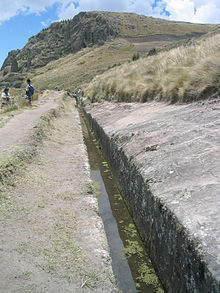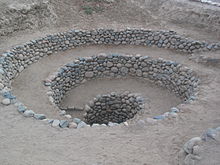Agricultural history of Peru
This articleneeds additional citations forverification.(January 2010) |
Theagricultural history of Peruincludes agriculture, cultivation of plants and herbs and general changes in the history of farming in Peru or its historical regions.
Pre-history
[edit]Much of thepre-history of Peruwas driven by the location of farmable land. The most populated coastal regions of Peru are the two parallel mountain ranges and the series of 20 to 30 rivers descending through its coastal desert. In dry periods only the mountains had enough rainfall for agriculture while the desert coast was empty.
In wet periods many cultures thrived along the rivers. TheIncawere a mountain-based culture that expanded when the climate became wetter, often sending conquered peoples down from the mountains into fallow but farmable lowlands. In contrast, theMochewere a lowland culture that died out after a strongEl Niño,which caused abnormally high rainfall and floods followed by a longdrought.[1]
A study reported that crops ofsquash,peanuts,andcottonwere domesticated in Peru around 10,000, 8,500, and 6,000 years ago, respectively. They were grown by theÑanchocpeople in the Ñanchoc Valley. No earlier instances of the farming of these crops are known.[2]
Humboldt current
[edit]Peru is both afflicted and blessed by a peculiar climate due to theHumboldt Current.Beforeover fishingkilled its fishery, Peru had the world's most productive fishery due to the cold Current. It lifts nutrients from the Pacific floor to surface waters. On land, it results in a cold mist that covers coastal Peru to the extent that desert plants have adapted to obtain water from the air instead of from (infrequent) rainfall. The wet side soil is thin, while few rivers operate on the dry side. This means all the water must be brought from the Atlantic side of theAndeanmountain ranges that split Peru.
Many obstacles limited Peru's agricultural production. Peru has always been rich innatural resourcessuch astin,silver,gold,guanoandrubber.These resources were found, not grown. Train tracks did not connect its peoples; instead they connected the sources of these valuable resources to the sea. So few ways helped to bring agricultural products to market.
The road system is underdeveloped in Peru, e.g., offering no connection to neighboringBrazil.Only a little over a quarter of the 15th-centuryInca road systemhas been modernized. Another obstacle is the large size of Peru's informal economy. This prevents Peru from relying on an income tax to run the government. Much of its revenue instead comes from a 13% tax on gross agricultural sales. This squeezes Peruvian farmers who must compete with farmers in countries that tax farmers on net profit. No profit, no tax.
Twenty-first century Peru grows agricultural commodities such asasparagus,potatoes,maize,rice,quinoaandcoffee.[3]Peru provides half of the world supply ofquinoa.[4]Peruvian agriculture uses synthetic fertilizers rather than still-abundant guano due to infrastructure issues. Peruvian maize is not exportable due to large producer subsidies in Europe and the United States. Coffee is exportable, because little is grown in those countries. In recent years Peru has become the world's primary source of high-qualityorganic coffee.[5]Peru does not have a quality control program such asKenya's, but its government has worked to educate farmers on how to improve quality. Despite the glut of coffee in the market today, coffee production in Peru's unusual high altitudes and partial shade allowsCoffea arabicato flourish, and it has much more of such land available than competitors such asJamaicaand Hawaii.
Aqueducts and terraces
[edit]

The ancient people of Peru built water-moving and preserving technologies like theaqueductsofCumbe Mayo(c.1500 BCE) and theNazca's underground aqueducts calledPuquios(date uncertain), or the terraced gardens of theHuari.Aqueducts were also utilized by the Moche.[6]
Another technique used for farming wasterracing.TheChavin,[7]Moche,[6]and Incas built terraces, orandenes,into the sides of hills. The andenes reduced erosion that would normally damage a steep hill. These terraces are still used.[8]Incans irrigated their fields with a system of reservoirs and cisterns to collect water, which was then distributed by canals and ditches.[9]
However, by the mid-19th century, only 3% of Peru's land was still farmable. It lagged behind many other South American countries in agriculture.
Guano
[edit]In the 19th century theIncafertilizerguano(saltpetre) became the most important resource in Peru's modern history, for its use as a fertilizer and asgunpowder.[10]The stock of guano built up because the Humboldt current once drew thousands ofanchoviesand other fish, which in turn, attracted thousands of birds. The population ofwhite-breasted cormorants,gray pelicansand piqueros flourished due to a lack of predators. The guano (droppings) left by the birds retained its nitrate content because of the arid climate.[11]Between 1840 and 1880, Peru sold around 20 million tons of guano, mostly to Great Britain. Peru earned about 2 billion dollars in profit.
Peru lost its guano reserves to Chile (backed by theBritish Empire) in theWar of the Pacific.[12]By the late 19th century, 50% of the Peruvian government'srevenuewas going to pay off loans that had been guaranteed with guano sources taken by Chile - these debts were eventually paid by sending all the remaining guano to France when it was preparing for war. The Germans invented theHaber processshortly after the outbreak ofWorld War I,after which guano became almost worthless.
As Peru's guano reserves began to run out, the government restricted the guano industry to help stabilize the supplies. The collapse of Peru's bird population after the collapse of the fishery limited future supply of the fertilizer.[10]
Current production
[edit]Peru is one of the 5 largest producers ofavocado,blueberry,artichokeandasparagus,one of the 10 largest producers in the world ofcoffeeandcocoa,one of the 15 largest producers in the world ofpotatoandpineapple,and also has a considerable production ofgrape,sugarcane,rice,banana,maizeandcassava;its agriculture is considerably diversified.[13]
In 2018, Peru produced 10.3 million tons ofsugarcane,5.1 million tons ofpotato,3.5 million tons ofrice,2.2 million tons ofbanana,1.5 million tons ofmaize,1.2 million tons ofcassava,921 thousand tons ofpalm oil,645 thousand tons ofgrape,548 thousand tons ofpineapple,504 thousand tons ofavocado,481 thousand tons oftangerine,502 thousand tons oforange,369 thousand tons ofcoffee,383 thousand tons ofmango,360 thousand tons ofasparagus,270 thousand tons oflemon,252 thousand tons oftomato,207 thousand tons ofbarley,195 thousand tons ofwheat,188 thousand tons ofolives,187 thousand tons ofcarrots,175 thousand tons ofpapaya,175 thousand tons ofpepper,154 thousand tons ofartichoke,140 thousand tons ofapple,134 thousand tons ofcocoa,in addition to smaller productions of other agricultural products.[14]
There is also native agriculture and tools, such as thetacarpo,a tool used to cultivatePachyrhizus tuberosusby the people in thePeruvian Amazon.[15]
Peruvian agricultural products
[edit]-
Potato plants
-
Maize ears
-
Rice field
-
Rice plants
-
Flowering coffee tree
References
[edit]- ^Davidson, Nick (2 March 2005)."Lost society tore itself apart".BBC News.Retrieved18 November2019.
- ^"Peanuts, cotton, squash first farmed in Peru 6,000-10,000 years ago".Mongabay.com.Archived fromthe originalon 29 January 2013.Retrieved7 January2010.
- ^"The World Factbook - South America:: Peru".www.cia.gov.Retrieved18 November2019.
- ^"FAOSTAT".Food and Agriculture Organization of the United NationsStatistics. Archived fromthe originalon 1 April 2013.Retrieved12 April2013.
- ^"Peru: Organic Products Update 2008"Archived2012-10-18 at theWayback Machine.USDA Foreign Agricultural Service Global Agriculture Information Network. Retrieved 7 January 2010.
- ^abSayer 1999,p. 10.
- ^Wood 1996,p. 4.
- ^Sayer, page 25.
- ^Wood 1996,p. 18.
- ^abLeonard, Andrew."When guano imperialists ruled the earth".Salon.com. Retrieved 7 January 2010.Archived4 December 2009 at theWayback Machine
- ^Straw, Annelise; Sis/Ba '18; Sis/Ma '19."American University, Washington, D.C."American University.Archived fromthe originalon 15 January 2010.Retrieved18 November2019.
{{cite web}}:CS1 maint: numeric names: authors list (link)The Inventory of Conflict & Environment(ICE). - ^"War of the Pacific 1879-1884"Archived2005-03-10 at theWayback Machine.Wars of the World*. Retrieved 7 January 2009.
- ^Peru en 2018, by FAO
- ^Peru production in 2018, by FAO
- ^Oré Balbín, Isabel; Delgado Vásquez, Octavio; Sorensen, Marten; Kvist, Lars Peter; Mejía Carhuanca, Kember (2005)."El cultivo de chuin: una alternativa para la seguridad alimentaria y recuperación de suelos degradados en la Amazonía peruana".Instituto de Investigaciones de la Amazonía Peruana: 31.
{{cite journal}}:Cite journal requires|journal=(help)
Sources
[edit]- Sayer, Chloë (1999).The Incas.Raintree Steck-Vaughn.ISBN0817251251.OCLC38055933.
- Wood, Tim (1996).The Incas.Viking.ISBN0670870374.OCLC1089520927.





